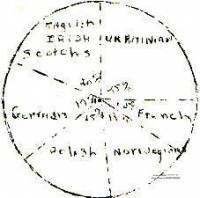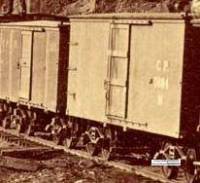Table of Contents

Bienfait- Early Settlers
Bienfait, Saskatchewan, Canada
WHERE THEY CAME FROM
from the 1955 History Book with some personal comments added here and there.
Because of the economic and political conditions of their homelands, the people set out for Canada around 1900. The talk of a new land lured settlers from the Ukraine, England, Ireland, Norway, Poland, France, Germany, Scotland and United States. Many of these people came about 1899 although settlers did not arrive in Bienfait until about 1902. Among them were blacksmiths, farmers, and shoemakers but when the town began to develop into a mining center, many other trades were practised. Many of the settlers left their families in their homelands until they had settled and made a suitable home for them, then they were sent for.
Graph below shows the approximate percentage of the distribution of the population in the Bienfait community
in the first decade (1900-1910) of the twentieth century.

HOW PEOPLE WERE ENTICED TO COME WEST
Because of the stirring tales of prospering relatives and promise of wealth and better living conditions people from many nations swarmed into the unsettled lands of the west. The settlers obtained their homesteads by paying ten dollars to the government and by signing an agreement promising to work the land for three years. At the end of these three years they received full ownership of this piece of land. The people received very little or no help from the government or land companies. Each settler brought or bought his own tools and prepared to make his own living in the untamed territories.
INCIDENTS OF TRAVEL
Transportation to seaports in the foreign countries was chiefly by train. The long voyage across the Atlantic took from one month to six weeks. Cattle-boats and steamships were only two of the many kinds of boats used to carry the immigrants to their new homes. It was very seldom that there was a shortage of water or food but housing accommodations were not adequate aboard the ships. Some of the ships were hindered by storm but others crossed with few mishaps. Usually there were no signs of plagues or sickness except a few cases of sea sickness. The people would travel from the port of some foreign country and land at the port at Quebec city. The voyage from the city of Quebec to Bienfait cost more than the voyage across the sea, but even so the fare was only a quarter of the price of the same trip to-day.
OLD TRAILS AND STOPPING PLACES
When the first settlers came to this district they brought their families with them. These settlers travelled for at least ten hours a day in which they covered from fifteen to twenty miles. In the summer the buggy was used while the bob-sled was used in the winter. The horse was about the most widely used animal to draw the sleds and wagons. The fee at a livery barn, and storage of cargoes was twenty-five cents a day. The goods they brought over the trails consisted chiefly of merchandise. When they went on trips their stopping place was usually at a hotel. These hotels were similar to our hotels only not as modern and up to date. The entertainment at these stopping places were supplied by traveling shows.
The Souris River at that time was used for transporting light weight goods. It is now used for sewage disposal, as a source of drinking water and fishing. The first dirt roads were built twenty years ago. Bienfait was never on a Trans-Canada trail.
CHARTERING BOXCARS
Boxcars were chartered principally for transporting coal and grain. Few shipments of cattle were made from Bienfait. The C.P.R. was the only railway to have a stockyard in Bienfait, therefore the C.N.R. did not ship any cattle. The cattle that were shipped from Bienfait were cared for by the shipper.
To charter a boxcar, a mining company, cattle shipper, or farmer made arrangements with the station agent, who had a supply of cars on hand, or could soon have one ready for use.
The shortage of boxcars in Bienfait was only momentary for each night a train of empty cars was brought in and kept on hand. The main use of the boxcars was for shipping coal. In the early days few cars were shipped, but now (1955) the mines have machines, more coal is dug, and more cars are needed to ship it. Sometimes 150 cars of coal are shipped in one day (1955). Grain and cattle are also shipped out of Bienfait. The cost of shipping 100 lbs. in the thirties was thirty-five cents, today (1955) it costs one dollar and ten cents. The low fee was the reason why the railroad has played an important part in the history of our community.

I remember my Dad, Phil Gent, telling stories of how he rode the trains from Bienfait to Arcola, in a boxcar, to pickup horses to be used in the underground mines south of Bienfait. His job was to buy them and transport them down to Bienfait, and then take them underground and look after them down in the mine.
SPECIAL TRAINS
The C.P.R. reached Bienfait in 1905 and the C.N.R. about 1909. At this time there was nothing on the town site except a pile of lumber. There were also a few farmers living a few miles from the Railway. Most of the settlers came by wagon or Ox cart and although the railway was handy, few settlers used it. The trains at that time were two-wheelers and much smaller and not as elaborate as the present day trains. The number of cars in the train is the same as it was in earlier years and the speed of the train was about 50 mph. the trains arrived earlier in the morning and earlier at night than they did in 1955. Special trains have taken people to the Brandon Fair or to a dance at one of the neighbouring towns. These special trains taking people to the dances were pulled by a mine engine which towed three or four flatcars upon which rode the merry makers.
(no drinking and driving even back then!)
I also have read that years ago, Threshing or Harvest trains would be sent out from Ontario, to the prairies, loaded with part-time labourers to work during the harvest in Sept. When the harvest was complete they would return back east.
©
